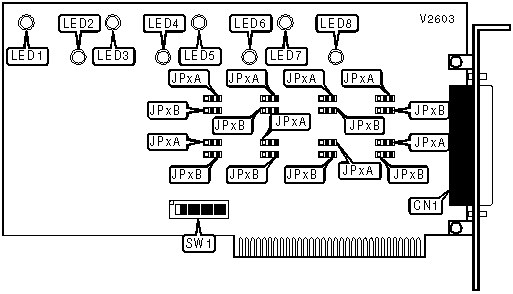
DECISION COMPUTER INTERNATIONAL CO., LTD.
8 CHANNEL RELAY OUTPUT/PHOTO-ISOLATOR
|
Card Type |
Data acquisition |
|
Chip Set |
NEC 8255 |
|
I/O Options |
Opto-isolated input and relay control output port |
|
Data Bus |
8-bit ISA |

|
CONNECTIONS | |
|
Function |
Label |
|
Opto-isolated input and relay control output port |
CN1 |
|
CN1 PINOUT | |||
|
Function |
Pin |
Function |
Pin |
|
Channel 1 relay open |
1 |
Channel 4 relay open |
20 |
|
Channel 1 relay common |
2 |
Channel 4 relay common |
21 |
|
Channel 1 relay closed |
3 |
Channel 4 relay closed |
22 |
|
Channel 2 relay open |
4 |
Channel 5 relay open |
23 |
|
Channel 2 relay common |
5 |
Channel 5 relay common |
24 |
|
Channel 2 relay closed |
6 |
Channel 6 relay open |
25 |
|
Channel 3 relay open |
7 |
Channel 6 relay common |
26 |
|
Channel 3 relay common |
8 |
Channel 7 relay open |
27 |
|
Channel 3 relay closed |
9 |
Channel 7 relay common |
28 |
|
Channel 8 relay open |
10 |
Ground |
29 |
|
Channel 8 relay common |
11 |
Channel 1 negative |
30 |
|
Channel 1 positive |
12 |
Channel 2 negative |
31 |
|
Channel 2 positive |
13 |
Channel 3 negative |
32 |
|
Channel 3 positive |
14 |
Channel 4 negative |
33 |
|
Channel 4 positive |
15 |
Channel 5 negative |
34 |
|
Channel 5 positive |
16 |
Channel 6 negative |
35 |
|
Channel 6 positive |
17 |
Channel 7 negative |
36 |
|
Channel 7 positive |
18 |
Channel 8 negative |
37 |
|
Channel 8 positive |
19 | ||
|
OPTO-ISOLATION OPTIONS | ||
|
Setting |
JPxA |
JPxB |
|
Differential signals (+ and -) |
Pins 1 & 2 closed |
Pins 2 & 3 closed |
|
Single-ended signals (+ and GND) |
Pins 1 & 2 closed |
Pins 1 & 2 closed |
|
Single-ended signals, TTL levels |
Pins 2 & 3 closed |
N/A |
|
Note:The exact locations of JP1A through JP8A and JP1B through JP8B are unidentified. JP1A and JP1B control the opto-isolation functions of channel 1. The settings for JP2A through JP8A and JP2B through JP8B are identical, controlling channels 2 through 8 respectively. | ||
|
BASE I/O ADDRESS | |||||||||
|
Setting |
SW1/1 |
SW1/2 |
SW1/3 |
SW1/4 |
SW1/5 |
SW1/6 |
SW1/7 |
SW1/8 | |
|
000h |
On |
On |
On |
On |
On |
On |
On |
On | |
|
004h |
On |
On |
On |
On |
On |
On |
On |
Off | |
|
008h |
On |
On |
On |
On |
On |
On |
Off |
On | |
|
010h |
On |
On |
On |
On |
On |
Off |
On |
On | |
|
014h |
On |
On |
On |
On |
On |
Off |
On |
Off | |
| » |
2A8h |
Off |
On |
Off |
On |
Off |
On |
Off |
On |
|
3ECh |
Off |
Off |
Off |
Off |
Off |
On |
Off |
Off | |
|
3F0h |
Off |
Off |
Off |
Off |
Off |
Off |
On |
On | |
|
3F4h |
Off |
Off |
Off |
Off |
Off |
Off |
On |
Off | |
|
3F8h |
Off |
Off |
Off |
Off |
Off |
Off |
Off |
On | |
|
3FCh |
Off |
Off |
Off |
Off |
Off |
Off |
Off |
Off | |
|
Note: Over 255 base address settings are available. The switches are a binary representation of the decimal memory addresses. SW1/1 is the Most Significant Bit and switch SW1/8 is the Least Significant Bit. The switches have the following decimal values: SW1/1=512, SW1/2=256, SW1/3=128, SW1/4=64, SW1/5=32, SW1/6=16, SW1/7=8, SW1/8=4. Turn off the switches and add the values of the switches that are off to 512 to obtain the correct memory address. (Off=1, On=0) | |||||||||
|
DIAGNOSTIC LED(S) |
|
The functions of the LEDs are unidentified. |